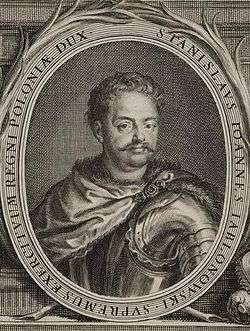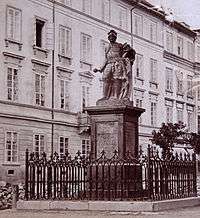Stanisław Jan Jabłonowski
| Hetman Stanisław Jan Jabłonowski | |
|---|---|
  | |
| Coat of arms | Prus III |
| Spouse(s) | Marianna Kazanowska |
|
Issue
Jan Stanisław Jabłonowski Jadwiga Teresa Jabłonowska Anna Jabłonowska Aleksander Jan Jabłonowski Stanisław Karol Jabłonowski | |
| Noble family | Jabłonowski |
| Father | Jan Jabłonowski |
| Mother | Anna Ostroróg |
| Born |
April 3, 1634 Łucza, Kingdom of Poland |
| Died |
April 3, 1702 (aged 68) Lwów, Kingdom of Poland |
Stanisław Jan Jabłonowski (1634–1702) was a Polish nobleman, magnate, Grand Guardian of the Crown since 1660, the Grand Camp Leader of the Crown since 1661, voivode of the Ruthenian Voivodship since 1664, Field Crown Hetman since 1676, Great Crown Hetman since 1683 and castellan of Kraków since 1692. Jabłonowski was a candidate for the Polish Throne following the death of King John III Sobieski.[1]
A talented and skillful political and military leader, Jabłonowski participated in the War with Sweden during The Deluge, then with the Cossacks and Muscovy. He took part in the Chocim campaign of 1673 and participated in the Vienna expedition of 1683. He led the right wing of Polish cavalry forces at the Battle of Vienna. He also stopped the Tatars at Lwów in 1695. In 1692 Jabłonowski built the stronghold and the neighbouring town of Okopy Świętej Trójcy. During the Royal election of 1697, he supported Augustus II, later in opposition to the King.
His daughter Anna Jabłonowska, who married Rafał Leszczyński, was the mother of King Stanisław I.[1]
Biography
Early life, studies and first commands
Stanisław was son of the Lord Sword-Bearer Jan Jabłonowski (1600–1647) and Anna Ostroróg, the daughter of author and scholar Jan Ostroróg. Jabłonowski began his military career in 1655, leading several battles against Russia and the Cossacks. In 1657 he took part in the war against Moldavia and George II Rákóczi. Later he distinguished himself during the war with Sweden (1656), known as "The Deluge", fighting under the command of the great general Stefan Czarniecki. In 1659 he fought in Polish occupied Ukraine under the command of Stanisław "Rewera" Potocki and Jerzy Sebastian Lubomirski. From 1664 he was the voivode (governor) of Ruthenia and in later years he fought against the invading Turks and Tatars, alongside with Hetman John Sobieski (future King John III). He took part in the Polish-Cossack-Tatar War of 1666–71, he commanded a unit belonging to Sobieski, most notably, at the battle of Podhajce.[2]
Professional military career
After the unexpected abdication of King John II Casimir in 1668, Jabłonowski supported the candidacy of the French prince Louis, Grand Condé to the Polish crown. In 1673 he led the successful charge of the Polish winged hussars at Chocim and in 1674 he successfully defeated the Turkish garrison in Kamieniec Podolski. In 1675 Jabłonowski defended the city of Złoczów against the Turks and in 1676 he commanded a part of the Polish army near Żurawno.
At the Battle of Vienna he commanded the Polish right wing of the allied forces.

During the 1673 election, Jabłonowski, being fierce supporter of John Sobieski, greatly contributed to Sobieski's election as king. In 1676 Jabłonowski was nominated as the Field Hetman of the Polish forces and from then on became the protector the south-eastern provinces of the Kingdom of Poland, known as Kresy or Kresy Wschodnie (lit. Eastern Borderlands). In 1683 the Sejm (parliament) granted him the Hetman's baton. Previously, however, because in 1681 he was active in political life, he was accused of being part of several intrigues against King John III. For this reason, the king didn't allow the parliament to grant him any titles. In the following years he participated in all the battles on the south-eastern fringe; in 1685 he led the unsuccessful expedition to Bukovina and in 1686 he took part in an expedition to Wallachia. In 1692 he became the castellan of Kraków. In the same year he unsuccessfully besieged Kamieniec Podolski, which has previously fallen into enemy hands. In 1694 he took part in the campaign near the town of Uścieczko where he crushed the allied Tatar and Turkish forces. In 1695 he took part in the great defeat of the last Tatar army at the Battle of Lwów, for which the people of the city erected a monument and a statue with the likeness of Hetman Jabłonowski. In his honor, one of the main streets of the city was renamed to Hetmańska – literally meaning Hetman's Avenue. After the death of King John III Sobieski (1696) he was one of the leading candidates for the crown, however due to the intervention of the Russian and Saxon forces, the Elector of Saxony, Augustus II the Strong, was chosen instead.
In 1699 the Ottomans returned the city and fortress of Kamieniec Podolski, which was again lost during the unsuccessful reign of Michael I.
Jabłonowski's long life was marked by a large sacrifice, primarily as a warrior, and for the purposes of the war he did not spare any of his own, private money, for which he enjoyed great success and popularity among his soldiers and political allies.[2]
He died on April 3, 1702.
Battle of Vienna and relationship with Sobieski

In the Battle of Vienna Jabłonowski commanded the right wing of the Polish army. In the subsequent years, the heavy burden of command in the expedition against the Turks and Tartars affected both Jabłonowski and the King. Popular among his soldiers, he spent large sums of money on military expeditions and from his own resources maintained garrisons and frontier fortresses. These fortresses not only protected the country's eastern borderlands, but also protected his own assets located within the Ruthenian Voivodeship. During the reign of John III, Jabłonowski believed that after the death of the monarch he would receive the crown. In 1687, during the long illness of John III, Queen Maria Kazimiera hinted that while widowed she could marry the Hetman. After the death of Sobieski in the year 1696, Jabłonowski supported the candidacy of Prince James Sobieski, but the majority of the nobility at the election in 1697 was in the favour of the Saxon Elector Frederick Augustus I, later crowned as Augustus II.[2]
References
Bibliography
- Mała Encyklopedia Wojskowa, 1967, Wydanie I
External links
- The Princely House of Jablonowski at the Wayback Machine (archived October 28, 2009) by Rafal Heydel-Mankoo